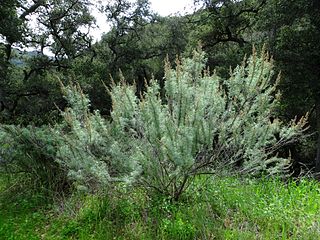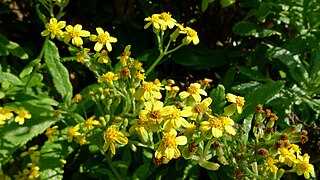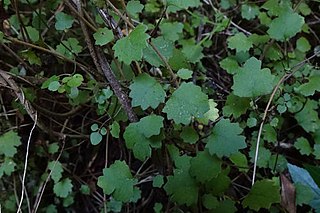
A shrub is a small-to-medium-sized perennial woody plant. Unlike herbaceous plants, shrubs have persistent woody stems above the ground. Shrubs can be either deciduous or evergreen. They are distinguished from trees by their multiple stems and shorter height, less than 6–10 m (20–33 ft) tall. Small shrubs, less than 2 m (6.6 ft) tall are sometimes termed as subshrubs. Many botanical groups have species that are shrubs, and others that are trees and herbaceous plants instead.

Senecio is a genus of flowering plants in the daisy family (Asteraceae) that includes ragworts and groundsels.

Devil's club or devil's walking stick is a large understory shrub native to the rainforests of the Pacific Northwest, but also disjunct on islands in Lake Superior. It is noted for its large palmate leaves and erect, woody stems covered in noxious and irritating spines. It is also known as Alaskan ginseng and similar names, although it is not a true ginseng.

Rosa 'Schoener's Nutkana' is a deep pink rose variety named after Father Georg Schöner (1864–1941), a priest who became a notable rose breeder, who developed this rose in 1930 as a cross between Rosa nutkana and the hybrid perpetual 'Paul Neyron'.

Xerochrysum bracteatum, commonly known as the golden everlasting or strawflower, is a flowering plant in the family Asteraceae native to Australia. Described by Étienne Pierre Ventenat in 1803, it was known as Helichrysum bracteatum for many years before being transferred to a new genus Xerochrysum in 1990. It is an annual up to 1 m (3.3 ft) tall with green or grey leafy foliage. Golden yellow or white flower heads are produced from spring to autumn; their distinctive feature is the papery bracts that resemble petals. The species is widespread, growing in a variety of habitats across the country, from rainforest margins to deserts and subalpine areas. The golden everlasting serves as food for various larvae of lepidopterans, and adult butterflies, hoverflies, native bees, small beetles, and grasshoppers visit the flower heads.

Jacobaea maritima, commonly known as silver ragwort, is a perennial plant species in the genus Jacobaea in the family Asteraceae, native to the Mediterranean region. It was formerly placed in the genus Senecio, and is still widely referred to as Senecio cineraria; see the list of synonyms (right) for other names.

Artemisia californica, also known as California sagebrush, is a species of western North American shrub in the sunflower family.

Delairea is a plant genus within the family Asteraceae that is native to South Africa. Classified within the tribe Senecioneae, it contains only one species, Delairea odorata, which was previously included in the genus Senecio as Senecio mikanioides. It is known as Cape ivy in some parts of the world (US) and German ivy in others. Other names include parlor ivy and Italian ivy. Its multi-lobed leaves somewhat resemble those of the unrelated English ivy.

Brachyglottis is a genus of flowering plants in the family Asteraceae. The genus was erected on November 29, 1775, by Johann Reinhold Forster and Georg Forster. The name was derived from the Greek brachus ("short") and glottis a reference to the size of the ray florets.

Euphorbia misera is a semi-succulent shrub in the genus Euphorbia commonly known as the cliff spurge or coast spurge. A drought-deciduous shrub, it is typically found as a gnarled, straggly plant occupying seashore bluffs, hills and deserts. Like other members of its genus, it has a milky sap, which can be found exuding out of the light gray bark when damaged. The alternately-arranged leaves are round and folded in the middle, with small hairs on them. The "flowers" can be found blooming year-round, and are colored maroon or yellow in the center with 5 white to light-yellow petal-like appendages attached outside. This species is native to the Baja California peninsula and Sonora in Mexico, and the coast of southern California in the United States, where it is a rare species. It is threatened in some localities by the development of its coastal habitat, which tends to be prime locations for high-end residential and commercial developments.

Senecio angulatus, also known as creeping groundsel and Cape ivy, is a succulent flowering plant in the family Asteraceae that is native to South Africa. Cape ivy is a scrambling and a twining herb that can become an aggressive weed once established, making it an invasive species. It has been naturalised in the Mediterranean Basin, where it is grown as an ornamental plant for its satiny foliage and sweet-scented flowers. Other names include climbing groundsel, Algerian senecio, and scrambling groundsel.

Senecio tamoides, also known as Canary creeper, is a climbing member of the genus Senecio of the family Asteraceae that is native to Southern Africa. It is used as an ornamental plant for its showy yellow, daisy-like flowers in autumn.

Senecio crassiflorus, in Portuguese: margarida-das-dunas, one of the native South American Senecio and an herbaceous dune dwelling perennial.

Senecio madagascariensis, also known as Madagascar ragwort, is a species of the genus Senecio and family Asteraceae that is native to Southern Africa. Other common names include Madagascar groundsel and fireweed. It has been included on the noxious weeds list for Hawaii and the reject list for Australia. S.madagascariensis is the diploid cytotype of S.inaequidens.

Brachyglottis monroi is a species of plant in the family Asteraceae, formerly classified in the genus Senecio. Native to New Zealand and Tasmania, it is a small, hardy, evergreen shrub growing to 1 m with crinkly-edged, olive green, leathery leaves and yellow daisy-like flowers in terminal corymbs in summer.

Brachyglottis elaeagnifolia is a species of flowering plant in the family Asteraceae. It is endemic to New Zealand, where it is limited to the North Island.

Pachystegia is a genus of shrubs in the family Asteraceae, known as Marlborough rock daisies, with distinctive leathery leaves and daisy-like flowers. They are naturally found only in dry areas of the north-eastern South Island of New Zealand.

Jovellana repens is an endemic New Zealand plant in the family Calceolariaceae spread through both the North and South Islands. It has small green leaves and white flowers with spots of purple on the inside.

Brachyglottis sciadophila, commonly known as climbing groundsel, is a flowering plant in the family Asteraceae. It has long stems with small green leaves and bright yellow flowers. It is the only climbing daisy which has yellow flowers that is endemic to New Zealand.



















